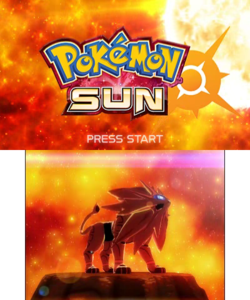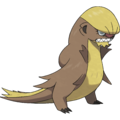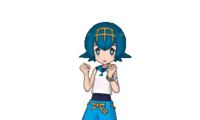Generation VII

|
The subject of this article has no official name. The name currently in use is a fan designator; see below for more information. |

|
This section is incomplete. Please feel free to edit this section to add missing information and complete it. Reason: Missing Pokémon Ultra Sun & Ultra Moon Title Screens. |
| Generation VII | ||||||||||||||||||||||
|---|---|---|---|---|---|---|---|---|---|---|---|---|---|---|---|---|---|---|---|---|---|---|
| ||||||||||||||||||||||
| ||||||||||||||||||||||
The seventh generation (Japanese: 第七世代 seventh generation) of Pokémon games is the seventh installment of the Pokémon video game series starting with Pokémon Sun and Moon and continuing with Pokémon Ultra Sun and Ultra Moon. Like Generation VI, the games of the seventh generation are presented on the Nintendo 3DS; it is the last generation on that console.[1]
History
The seventh generation of Pokémon was announced with the reveal of Pokémon Sun and Moon on February 27, 2016, the Pokémon 20th Anniversary. These games were released worldwide on November 18, 2016, except in Europe where they were released on November 23, 2016.
The second pair of games in this generation, Pokémon Ultra Sun and Ultra Moon, were revealed in a Pokémon Direct held on June 6, 2017. The games will once again take place in Alola, but with a new story and will include Pokémon that cannot be found in Sun and Moon. The games are set to be released worldwide on November 17, 2017.
The Generation VII games are not isolated from previous iterations. Pokémon Sun and Moon and Pokémon Ultra Sun and Ultra Moon can communicate with the application Pokémon Bank, which can also communicate with the Generation VI games. Additionally, the Generation V games and the Virtual Console releases of the Generation I and II games can send Pokémon to Pokémon Bank through Poké Transporter. Through Pokémon Bank, Poké Transporter, Poké Transfer, and Pal Park, Pokémon from any generation can be transferred to Generation VII.
Advances in gameplay
- The addition of 81 new Pokémon, bringing the total to 802.
- The addition of 80 new moves, bringing the total to 701.
- The addition of 41 new Abilities, bringing the total to 232.
- A new region to explore, the Alola region, based on Hawaii.
- The return of different overworld themes depending on the time of day, which was originally introduced in Generation IV.
- A new villainous team, Team Skull.
- Several Generation I Pokémon have a form unique to Alola known as a regional variant; this aspect of Generation VII is based on selective pressures which occur in the real world.
- The player can move freely in any direction in any area of the game, as opposed to the eight-directional grid of the previous generation.
- The addition of the Rotom Pokédex, a special Pokédex inhabited by a Rotom that doubles as a real-time map on the bottom screen of the Nintendo 3DS.
- The 3D models used for characters on the overworld are refined, and Trainers can be seen behind their Pokémon during battle, similar to Pokémon Colosseum, XD: Gale of Darkness, and Battle Revolution.
- Certain NPC trainers may keep their Pokémon in Poké Balls other than the standard Poké Ball.
- A new battle mechanic, Z-Moves, powerful moves that Pokémon can learn and perform once per battle.
- The addition of the island challenge, a traditional rite in the Alola region involving trials guided by Trial Captains, battling Totem Pokémon, and battles with Island Kahunas.
- The introduction of Greninja's Ash-Greninja form and Zygarde's four alternate forms, previously shown in the XY&Z arc of the anime's XY series.
- Six new Pikachu forms based on Ash's Pikachu.
- Two new battle modes:
- A battle that takes part between four Trainers called a Battle Royal, where each participating Trainer aims to defeat each other. The battle ends when all of one Trainer's Pokémon are knocked out, with the winner being the Trainer who has the highest combined number of knockouts and number of remaining Pokémon.
- A battle where wild Pokémon can summon allies to assist them called an SOS Battle.
- The new QR Scanner allows players to register Pokémon in their Pokédex and receive event Pokémon.
- The addition of Poké Rides, which allow players to summon Pokémon that they can ride to access otherwise inaccessible areas.
- The addition of Hyper Training, a system that allows players to exchange special Bottle Caps to maximize the IVs of their Level 100 Pokémon.
- The introduction of the Zygarde Cube, an item that allows the player to collect Zygarde Cells and Cores scattered across the region to assemble their own Zygarde.
- The addition of the Festival Plaza, a hub accessible from the menu that allows the player to interact with other players locally or via the internet, as well as access various shops similarly to Join Avenue.
- The addition of the Poké Pelago, an option accessible from the menu that allows the player to send Pokémon that are stored in a PC Box to various islands, allowing them to gather items, discover wild Pokémon, and even raise their levels and stats.
- The player can now replace one of their party Pokémon with a newly caught Pokémon without having to use a PC.
- One new variant of Poké Ball, the Beast Ball, retaining the 26 found in previous games.
- The introduction of a new evolutionary stone, the Ice Stone.
- During a Pokémon battle, the bottom screen now displays a move's type effectiveness once the player has encountered the Pokémon again.
Alterations from Generation VI
- Several Pokémon can learn new moves upon evolution.
- Pokémon-Amie is replaced by Pokémon Refresh.
- The Player Search System is replaced and incorporated into the Festival Plaza.
- The abandonment of the following elements:
- Counting how many of each species of Pokémon the player has encountered.
- The National Pokédex, with Pokémon from outside the Alola Pokédex having no Pokédex entry at all.
- Horde Encounters, Sky Battles, Inverse Battles*, Triple Battles, and Rotation Battles.
- Super Training, O-Powers, and Poké Miles.
- Contest Spectaculars, Cosplay Pikachu, Super-Secret Bases, Mirage spots, Soaring, and the DexNav from Pokémon Omega Ruby and Alpha Sapphire.
- The Hall of Fame PC function.
- The experience formula once again takes in account the difference between the Pokémon's levels.
- A Pokémon's speed after Mega Evolution is used to determine the turn order, not its Speed before.
- The following status conditions have been altered:
- Moves can no longer be used outside of battle.
Further additions in Ultra Sun and Ultra Moon
- An altered story from Sun and Moon.
- A new post-game scenario, Episode RR, featuring a new villainous team, Team Rainbow Rocket; an alliance between the leaders of the teams of the previous generations.
- Five new Pokémon are introduced: Poipole, Naganadel, Stakataka, Blacephalon, and the Mythical Pokémon Zeraora, bringing the total to 807.
- The introduction of several new forms.
- Three new forms for Necrozma, which plays a central role in the story in Pokémon Ultra Sun and Ultra Moon.
- An additional Pikachu form based on Ash's Pikachu as it appeared in the movie I Choose You!.
- An additional form for Lycanroc which debuted in the anime's Sun & Moon series.
- The addition of three new moves (Mind Blown, Photon Geyser, and Plasma Fists) and six new Z-Moves (Lycanroc's Splintered Stormshards, Mimikyu's Let's Snuggle Forever, Kommo-o's Clangorous Soulblaze, Solgaleo's Searing Sunraze Smash, Lunala's Menacing Moonraze Maelstrom, and Ultra Necrozma's Light That Burns the Sky), bringing the total amount of moves to 719.
- One new Ability is introduced: Ultra Necrozma's Neuroforce, bringing the total to 233.
- An expanded Alola Pokédex, bringing the total to 403.
- A fleshed out Rotom Pokédex, including the the Roto Loto feature.
- New hairstyles and clothing.
- The expansion of Ultra Space and several new locations in Alola.
- The introduction of a new Poké Ride and mini-game: Mantine Surf.
- The introduction of the Alola Photo Club.
- The introduction of the Battle Agency, an addition to the Festival Plaza.
- The replacement of Zygarde Cells and Cores with Totem Stickers, which the player can redeem to receive special, Totem-like Pokémon.
Region
Alola
- Main article: Alola
The Alola region was introduced in Pokémon Sun and Moon. This island region is made up of four main islands and one artificial island.
Starter Pokémon
The starters of the seventh generation follow the traditional Grass/Fire/Water trio setup. At the beginning of the game, the player must choose between the Grass and Flying-type Rowlet, the Fire-type Litten and the Water-type Popplio.
Trial Captains and Totem Pokémon
In Sun and Moon, there are seven Trial Captains and eight Totem Pokémon, Pokémon which are bigger than the rest of their species and have "auras" that increase one of their stats at the beginning of battle. Upon a Totem Pokémon's defeat, the player will get the corresponding Z-Crystal of the same type of the trial.
In Ultra Sun and Ultra Moon, many of the trials, with the exception of the first, are altered in some way. In addition, the final Trial Captain, Mina has a trial for the player to complete.
Grand trials
After the player completes all the trials on an island, they must battle the kahuna of the island.
| Grand trials | ||
|---|---|---|
| Generation VII | Region: Alola | |
| Island Kahuna Japanese |
Location Japanese |
Type |
 Hala ハラ Hala |
Iki Town リリィタウン Liliʻi Town |
Fighting |
 Olivia ライチ Lychee |
Ruins of Life 命の遺跡 Ruins of Life |
Rock |
 Nanu クチナシ Kuchinashi |
Malie City マリエシティ Malie City |
Dark |
 Hapu ハプウ Hapū |
Vast Poni CanyonSM ポニの大峡谷 Great Canyon of Poni |
Ground |
| Exeggutor IslandUSUM ナッシー・アイランド Nassy Island | ||
English title screens
| Pokémon Sun | Pokémon Moon |

|

|
Japanese title screens
| Pokémon Sun | Pokémon Moon |

|

|
Trivia
- Generation VII is the only generation in which:
- There are no Gym Leaders, Gyms, or Badges.
- Bicycles and Gates do not appear.
- HMs, field moves, and cuttable trees are not present.
- A Legendary Pokémon that is part of an evolutionary family was introduced.
- Brand new species of Pokémon are introduced in later games in the generation, and cannot be traded to the earlier games.
- Generation VII is also the only generation that did not introduce:
- A Pokémon that evolves through trading.
- A Pokémon with gender differences.
- A notable Ice-type expert.
- A Champion that precedes the player.
- Generation VII introduced the most Legendary Pokémon, with ten.
References

|
This game-related article is part of Project Games, a Bulbapedia project that aims to write comprehensive articles on the Pokémon games. |











































